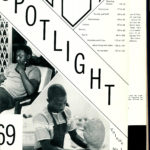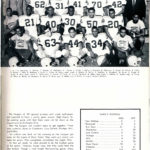
West Side High School, Gary, Indiana
For three days in March 1972, the city of Gary, Indiana hosted approximately 8,000 black political leaders and citizens from across the nation. These delegates came together to form the National Black Political Convention, “a distinctly black political movement” independent from both major American political parties. Throughout the weekend, delegates aimed to discuss the future of African American people in America and to create a National Black Agenda that would address nationwide poverty and high unemployment rates of African Americans, along with the general alienation of African Americans from the political system across party lines.
The city of Gary was chosen to host the convention despite its relatively small size and few accommodations. Gary had only one hotel at the time but was chosen “because it was a predominantly black city governed by an elected black mayor, who was able to ensure a welcoming environment for the thousands of black delegates and visitors to the convention.” In 1972, Gary had a population of about 175,000, half of which were African American. Mayor Richard Gordon Hatcher had been elected in November 1967 and was the first African American mayor in Indiana’s history. Along with Mayor Carl Stokes of Cleveland, elected the same year, Hatcher was also the first African American mayor “to head a major American city.” Hatcher was the chair of the planning conference for the convention held on September 24, 1971, and offered Gary as a host city, saying that “We should do it at a place where Black people from all over the country could feel comfortable. Wouldn’t have to worry about the police beating them. Wouldn’t have to worry about getting cooperation from city officials.”
The National Black Political Convention took place in the gymnasium at Gary’s West Side High School, now called West Side Leadership Academy. West Side High School, built in 1968 to integrate students within the Gary School System, was the largest high school in Indiana at the time. The convention hoped to cultivate a neutral space for its diverse delegates, where everyone “from members of Congress to street gang members from Chicago would feel welcome.” The slogan “unity without uniformity” was the rallying cry of the convention, whose leaders hoped to create a united black political front without necessarily agreeing on methods of strategy or implementation. The National Black Political Agenda which was ratified during the convention was supposed to be representative of the collective political will of African Americans nationwide. From there, leaders of the convention “would then take this agenda to the Democratic and Republican National Conventions to determine which one of the two presidential candidates was more sympathetic to blacks.” Then, the agenda was hoped to serve as a guide for the president to “guide his relationship with black Americans.”
At a time when the country was still experiencing violent protests and racism, managing to host a black political convention of more than eight thousand African Americans represented empowerment and progress. Among the leaders was Reverend Jesse Jackson Sr., an activist who had worked alongside Martin Luther King, Jr. in the Southern Christian Leadership Conference. He delivered a passionate speech on the significance of the convention. Other speeches focused on African American political and economic freedom, and on tumultuous events such as the violence in Selma, Alabama, the Voting Rights Act, and the deaths of major African American political figures like Martin Luther King, Jr., and Malcolm X. One of the major subjects of discussion was Pan-Africanism, an intellectual movement which sought to unite people from Africa or from African descent in a collective movement internationally.
The National Black Political Convention in Gary was a euphoric event, filling its delegates with hope for the future and a sense of true empowerment. It represented a distinct moment in American history in which “a formidable collection of black Americans was energized by the possibility of stepping outside the confines” of mainstream white American politics. The energy the convention created in Gary has had a clear legacy in African American politics in the United States. The National Black Political Convention is credited with the organization of black voters and candidates which would lead to significant growth in the number of African American politicians elected nationwide; from 2,200 at the time of the convention in 1972 to more than 5,000 just ten years later.
West Side High School continues to be a success story for the City of Gary both athletically and academically. As the one remaining non-charter high school in the city, it serves both the community and its citizens well by providing a stellar program for our youth.
(Excerpts of this information are courtesy of the “National Black Political Convention and West Side High School,” Digital Civil Rights Museum, accessed June 15, 2021, https://www.digitalresearch.bsu.edu/digitalcivilrightsmuseum/items/show/49.)


























